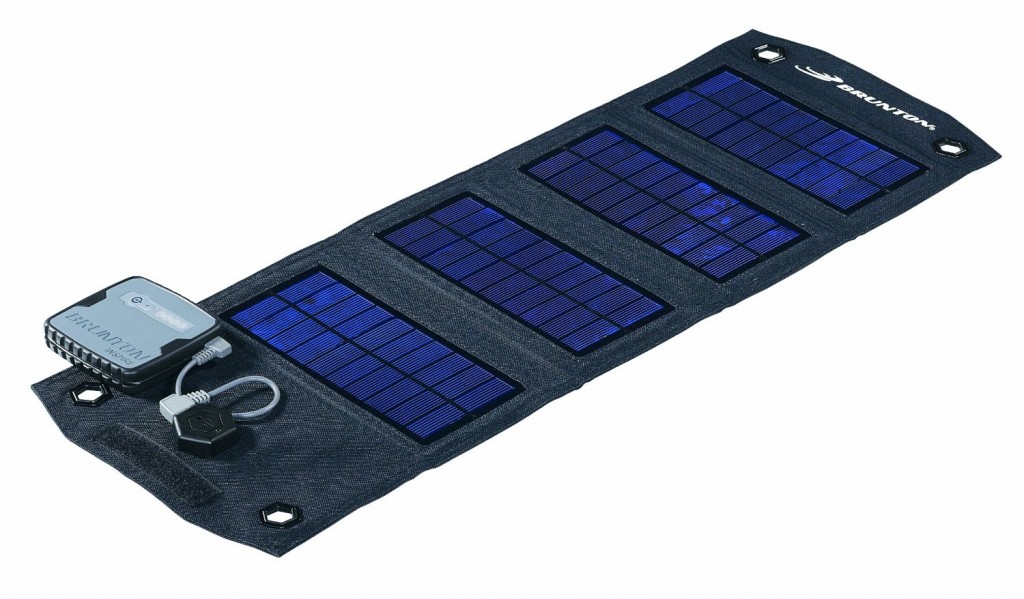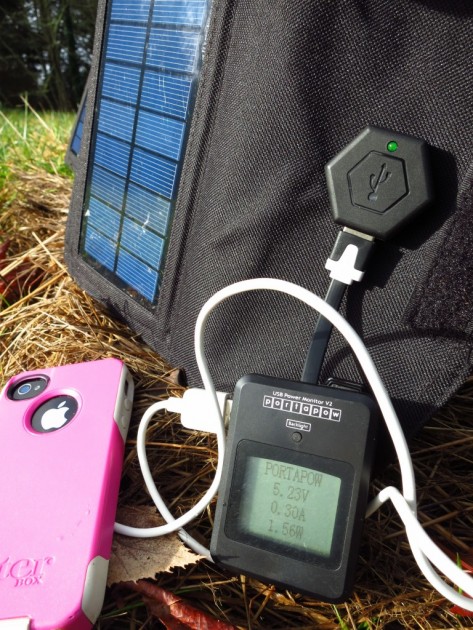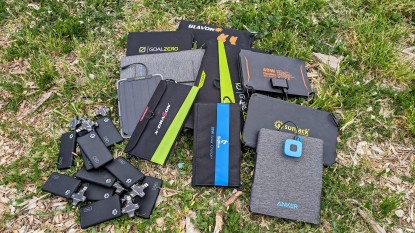Brunton Power Essentials Kit Review
Our Verdict
Our Analysis and Test Results
Upon careful inspection and a little math, the specs of the Brunton Power Essentials say it all--the Power Essentials kit is not pushing the envelope on solar output power or battery capacity. The panel and the battery both max out at 1 amp of current, and they each put out a trim 5 watts.
Output Power
The Brunton Power Essentials may not seem like a strong modern competitor in the solar market, but we would not rule this panel out. As most solar manufacturers continue to push the limits of sun harnessing technology, we are starting to see the consequences of excess: false hopes and disappointment. Really, every device is limited by its exposure to the sun. On one hand, it is great for a panel to be powerful enough to rapidly charge whatever you throw at it: for this, look at the Anker 15W PowerPort Solar.
But this panel produced 0.3A on a cloudy day when that's what most of the other panels could conjure up as well. We encountered a lot of limits using this kit, but it was reliable in its slowness, dependable though not powerful.
The Brunton solar panel is also made of polycrystalline cells instead of the more pure monocrystalline cells. This less pure crystal structure is less efficient than the rest of the panels in our review which are monocrystalline. Increasingly, monocrystalline panels are replacing all other types of solar panels in the lightweight/backpacking/personal panel niche of the industry. The higher quality means higher cost, but this is not as much of a deterrent to sales with smaller sized panels where ounces and cost are inversely valued. Choosing monocrystalline panels could be a significant uptick in price to power a home or a town, but negligible to the average small-panel consumer who will likely pay more for a smaller, lighter, but equally powerful panel.
As Renogy, a renewable energy company, says: “A monocrystalline cell consists of a single crystal ingot, whereas a polycrystalline cell consists of a growth containing multiple crystal structures. Both types of cells are made from silicon ingots, but the purity requirement of the silicon is higher on a monocrystalline base. Therefore, monocrystalline panels are more efficient, and thus, more expensive. By using a single cell, monocrystalline based silicon allows the electron greater freedom to move, so less energy is lost and higher efficiency is created. Most monocrystalline cells peak at 22% efficiency, whereas most polycrystalline cells peak at 18% efficiency. As polycrystalline cells are less expensive, they are often the top choice of large-scale contractors working within a budget.”
For the old-fashioned and mellower of pace, the Brunton Power Essentials may actually be a quite reliable option. Like your 1980s Toyota, it's reliable and sturdy and gets pretty good miles per gallon for a truck--just don't expect anything over 65mph going downhill on the freeway. The kit is just not that fast at charging anything. But if you have time and sun for many hours a day, this could be a simple and dependable panel to take out for weekend drives. Plus, it is only about two-thirds the cost of the Goal Zero Venture 30 kit.
Ease of Use
The Brunton Power Essentials kit includes the 5 watt panel and the Inspire battery pack. The concept is very similar to the Goal Zero Venture 30 Recharging Kit, but not quite as powerful or convenient.
The Inspire battery, for example, has the similar wrap-around micro-USB cord. However, it must be completely removed before you can charge any other device from the USB port (not the case on the Venture 30 battery). This opens up the risk of losing the cable while charging your phone. Additionally, the design of the wrap-around cord makes each end (the USB and micro sides) of it protrude, so it is more likely to get accidentally ripped out or damaged.
The output power of the Brunton panel and battery is also a limiting factor. The max charging amperage from either the panel or the battery is 1 amp, which makes it very slow for charging newer smartphones and tablets. The solar panel also has only one USB output, which is wise given the low wattage of the solar panel, but it does limit your charging options.
Weight
This setup was the third heaviest in the review, but does not make up for the extra weight as well as the Goal Zero Kit. Combined with the slow charging speeds, this is not a good bang-for-your-buck panel that justifies the extra weight in your pack for your weekend backpacking trip. It's a better fit for a mellow car camping trip with older phones or limited electronics.
Versatility
The Brunton Power Essentials kit is not as well paired, technologically, as the Goal Zero Venture 30. The Brunton solar panel is larger, with five panels, but it puts out only 5 watts versus the 7 watts of the Nomad 7 panel from the Goal Zero kit. And the Brunton Inspire battery is smaller, with less than half the charge capacity of the Goal Zero Venture 30. The polycrystalline solar panel is also a hindrance to this panel's versatility--it is less pure and less efficient.
Portability
The Brunton Power Essentials kit scores lowest in portability in this review. It has no pouch on the solar panel to carry the battery or any cords or other devices to be charged. This is not an insignificant detail in an increasingly competitive market. We were the most irritated working with this solar panel kit, always having two things to keep track of any time we packed it up or took it out to use it.
The shape and size of the panel also made it awkward to pack--if we describe most of the panels in this review as being designed like a small notebook, the Brunton solar panel would look more like a hot dog--longer and thicker. The narrower profile of each solar panel also means more folding and unfolding--the lower quality of the Brunton solar panel means they need more surface area for the same output.
Best Applications
The Brunton Power Essentials kit is a great kit for the newer solar enthusiast on a budget or a car camping enthusiast who enjoys mellow trips and owns older (and less power hungry) USB technology and gadgets. That's a lot of caveats, but it should paint the picture.
Value
We like to start assessing value with a simple calculation: price per watt. The solar panel in the Brunton Power Essentials kit is 5 watts, and the Inspire battery also puts out 5 watts. At about $110 for the kit, that makes $11 per watt, not a competitive price in this review. The Goal Zero Venture 30 Recharging Kit averaged about $10 per watt. Breaking it down per item, the Brunton Explorer solar panel is about $60 for 5 watts, or $12 per watt. And the battery $72 for 5 watts or about $14 per watt. But the discount of $22 for the kit is much better than the meager $10 discount for buying the Goal Zero kit.
Conclusion
The Power Essentials kit is lagging behind the times and due for an update, remake, or replacement (Brunton does offer many other products, but nothing to really replace the niche of this kit). It is still relatively popular, and it is well designed and reliable for what it is--it is just a bit underpowered for the modern race cars and cadillacs of the smartphone and tablet world.






